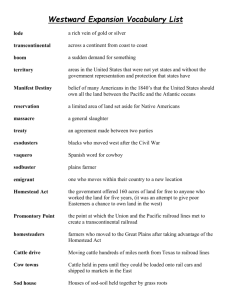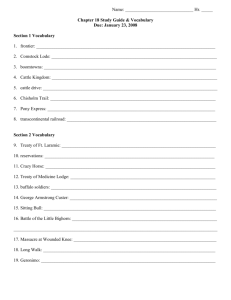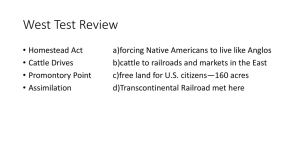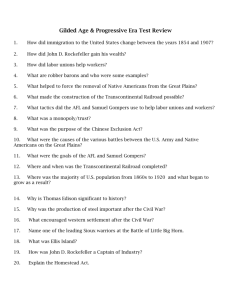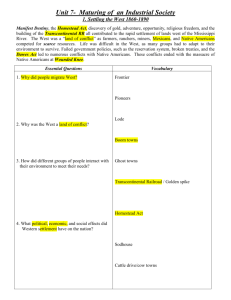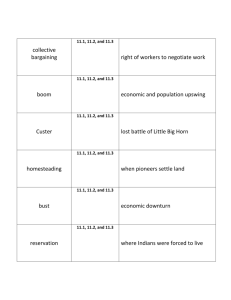The West and Gilded Age
advertisement
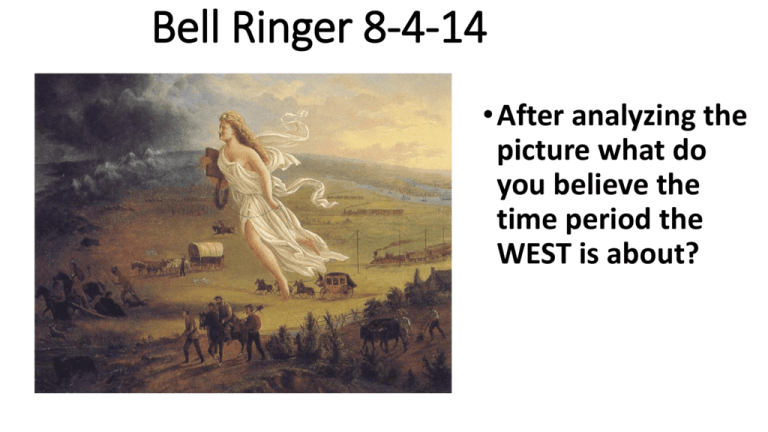
Bell Ringer 8-4-14 • After analyzing the picture what do you believe the time period the WEST is about? Closing Task •Students will be assigned a word, in pairs they have to 1. Define the term in their own words 2. Illustrate a picture describing the word 3. Once complete you will participate in a gallery walk, while filling out a Vocabulary Worksheet. Bell Ringer 8-5-14 •Why is technology vital to the U.S.A? •Technology helps raise the standard of living. (the way people live) West & Gilded Age Technology The Light Bulb •Thomas A. Edison invented the light bulb in 1879 Electric Light • The light bulb provided in a longer work day for workers. • It also improved quality of life by bringing light into dark homes and apartment buildings. Manufacturing • Electric power facilitated increased production in factories by lengthening the work day (light bulb) and powering faster machines. Petroleum-based products •Edwin L. Drake struck oil in 1859, enabling kerosene production and paving the way for future products such as gasoline. Steel Production • Steel production was necessary to help build the transcontinental railroads that would be a major social and economic drivers in the United States. • This greatly impacted the industrialization efforts in the early 20th century. Transportation • Mass transportation such the transcontinental railroad and the automobile increased the ability to travel distances and created new jobs. • This helped raise the standard of living because it allowed people to have more housing and employment choices. Telephone • Alexander Graham Bell invented the telephone in 1876. • This raised the standard of living because it allowed people to communicate faster. Closing Task •Individually you will work on the handout titled “Inventions and Innovations”. You may use the notes you took in in class or the Jarrett Book on page 63. Bell Ringer 8-6-14 •How did technology assist the population growth of the Great Plains? •Technology helped settle the Great Plains because it (Transcontinental Railroad) allowed people to travel west a lot easier and faster. Westward Movement 8/6/14 Settlement of the Great Plains • The Plains Indians were the earliest settlers in the Great Plains; located between the South and Midwest regions to the east and the Rocky Mountains to the west. • This land was ideal for farming due to its location. Homestead Act 1862 • The Homestead Act was passed in 1862 which provided that any adult citizen, or intended citizen, to claim 160 acres of surveyed government land at no cost. • The Homestead Act encouraged settlement. Farming Issues • Many white settlers took advantage of the Homestead Act which helped the Westward expansion. • There was new technology such as the steel plow which made it easier to break the dense soil and farm the land (increased settlement). • In the late 1800s famers began to rely on mechanization to improve and increase agricultural production. As a result, overproduction occurred and farmers went into debt. Cattle Industry Boom • Cattle industry boomed in the late 1800s as the culture and influence of the Plains American Indians declined. • There was a growing demand for beef in cities after the Civil War. • Railroads provided method of transportation of beef to urbanized areas. The First Transcontinental Railroad • The First Transcontinental Railroad in the United States was built in the 1860s, linking the well developed railway network of the Eastern coast with rapidly growing California. Transcontinental Railroad cont. • Industry relied on railroads for shipping. • Railroads grew in response to increased demands of industrialization and Western Expansion. • Railroads expanded westward to meet demands of settlement and economic development of the West. Railroads carried people and products to new markets in the West and across the United States. • Railroad shipping facilitated the growth of ranching, farming, and mining industries in the West. Klondike Gold Rush • Klondike Gold Rush – was during the late 1800s, in Northern Washington and Alaska • Thousands of people were hoping to ease the pains of economic depression, so they sold their farms, dropped businesses, and boarded ships to follow their dreams north because Alaska was seen as a large and distant source of raw materials. CHANGING DEMOGRAPHIC PATTERNS • Economic conditions and political persecution led many immigrants to enter the United States legally and illegally. • Large influxes of immigrants caused rapid growth in ports of entry and cities with heavy industry. CHANGING DEMOGRAPHIC PATTERNS cont. • Border states with Mexico have experienced greater cultural diffusion and a higher density of the Hispanic population due to proximity. • Western states have experienced greater cultural diffusion and a higher density of Asian populations due to proximity. Closing Task •Individually you will work on the “Westward Movement” handout. You may use your notes or the Jarrett book page 90 to complete your work. Bell Ringer 8-7-14 •What is the Free Enterprise System? Closing Task • Students will rotate around the room and complete several activities in each station for the following topics: • Political Machines • Industrialization • Rise of entrepreneurship • Free Enterprise • Big Business Bell Ringer: August 8, 2014 After the stations yesterday, analyze the picture and explain what you believe the political cartoon is about. Political and Economic Issues of the Gilded Age • Political machines Corruption in politics (e.g., Tammany Hall, Boss Tweed, Thomas Nast’s illustrations) • Leaders of the political machines known as political bosses gained support of the People by: • Making improvement to urban infrastructures • Providing jobs to immigrants and the poor • Giving favors to local businessmen. • The expectation was to then have support from these groups at the ballot box. Boss Tweed of Tammany Hill • Controlled thousands of city workers and influenced the operation of schools hospitals and other city-run services. • Tweed controlled and bribed lawmakers to pass laws favorable to his interests. • Overpaid himself on construction projects and land sales stealing millions from the city. Rise of Entrepreneurship • An entrepreneur is someone who organizes, manages, and assumes the risks of a business; an agent of change; discovers new ways to combine resources. • In the 1800s, many were considered entrepreneurs because they created value by moving resources out of less productive areas and into more productive ones. • Example: skilled immigrants used their trade skills to establish businesses of their own. • 1873, large producers like Carnegie and Rockefeller began driving smaller companies out of business or purchasing them. • Monopoly: eliminate competition • Pros: • • • • Large business are more efficient, leading to lower prices They can hire large number of workers They can produce goods in large quantities They have the resources to support expensive research and invent new items. • Cons: • • • • They have unfair competitive advantage against smaller businesses. They sometimes exploit their workers They are less concerned with where they do business and pollute the area They have an unfair influence over government policies affecting them. Andrew Carnegie • Worked from a penniless Scottish immigrant to one of Americas richest and most powerful men. • Invested in ironworks and built a steel mill in Pittsburgh, selling iron and steel to railroad companies for track. • Spent his later life doing philanthropic (giving money to the needy) activities (e.g., founding of Carnegie Hall). • “The Gospel of Wealth” (1889) set forth Carnegie’s idea that rich men are “trustees” of their wealth and should administer it for the good of the public. • As industry grew rapidly, the U.S. government promoted free enterprise (business that can operate competitively for profit with little government involvement/regulation). Closing Task I will complete the 2nd week 1st 9 week pulse check quiz. Good Luck!
